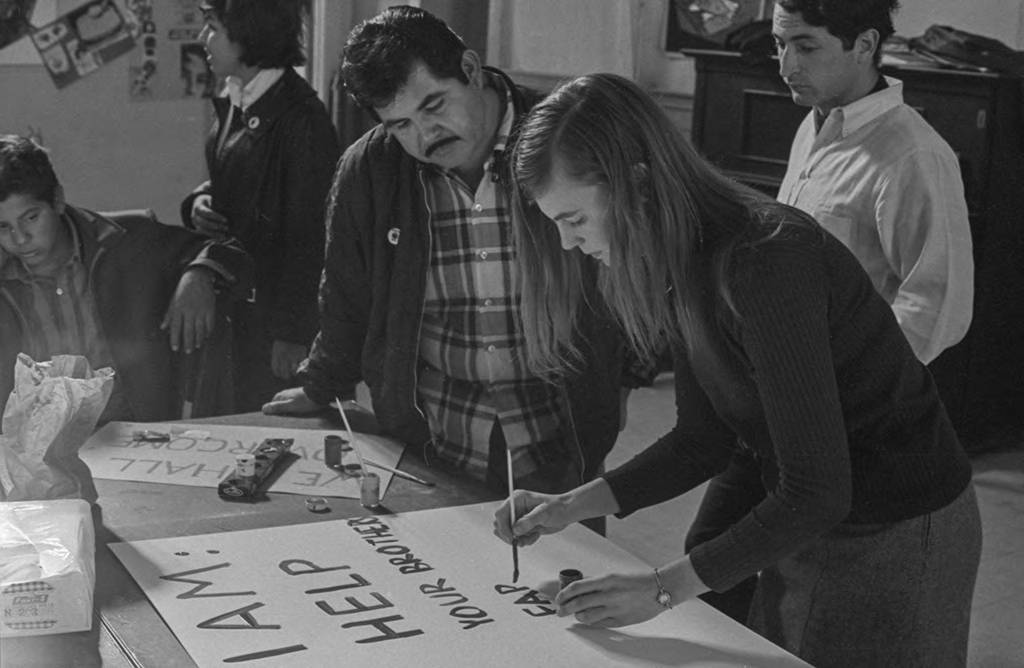Wendy Goepel
Wendy Goepel
Wendy Goepel sorting envelopes at Filipino Hall, Delano, ca. 1966. Photo by Emmon Clarke.
Wendy Goepel had a central role in the NFWA. She moved from Massachusetts to California in 1958, to join the California Migrant Ministry and study sociology at the University of California, Berkeley. She quickly learned in which conditions the farmworkers’ families were living as she spent her first Californian summer working and living in different labor camps near Bakersfield in Kern County. As a student from Berkeley, she traveled to Stockton to meet Dolores Huerta and Gilbert Padilla, and after earning her master at Stanford she quit her PhD studies to work on a new project at the California Health Department, the Farmworker Health Service.
Wendy Goepel talking to a driver, Delano, ca. 1966. Photo by Emmon Clarke.
From 1963 to 1965 she led a team of survey interviewers inquiring about the health, housing, and economic conditions of migrant farmworkers living in Kern, Kings, and Tulare County and writing reports about the health status of Black, Filipino, and Okie farmworkers. During these times she met César and Helen Chávez and formed Citizens for Farm Labor, a group that included other activists and unionists such Anne Draper and Bill Esher. Esher wanted to publish a magazine in Delano, and Goepel financed him by sending him $50 a month so that he could live and work in Delano, where he started the newspaper El Malcriado.
Wendy Goepel making picket signs at the Church of the Epiphany in Lincoln Heights, Los Angeles, 1966
UFW volunteer and organizer Wendy Goepel is working on marking picket signs in the basement of the Church of the Epiphany in Lincoln Heights, in Los Angeles. “This was in Los Angeles,” she said in an email after seeing this photograph. “After the harvest we went to LA to do informational picketing during shift changes at big manufacturing plants. Every car leaving the parking lot got leafletted; some gave small money; many gave encouragement; none could buy grapes after meeting us! There were about ten of us. I loved making signs and did it a lot in the church basement where we were living on their floor.”
In the winter of 1965 Goepel got a new job working at Governor Pat Brown’s office for the War on Poverty in California project. That didn’t last long and the project did not benefit the farmworkers as valley growers were democrats and the democrat governor did not intend to upset them in a significant way. But it is during this time that Goepel got closer to Chávez. She was working on six grant applications in the San Joaquin Valley for local improvement projects, one of which was for the NFWA. In September 1965, when César Chávez asked her to join the NFWA she did not hesitate.
Wendy Goepel working at a desk in the NFWA office, Delano, ca. 1966. Photo by Emmon Clarke.
On September 16, a day after a strike vote was called at Filipino Hall, Goepel quit her job at Farmworkers Health Services and joined Chávez. In the fall of 1965, as soon as the strike began, Goepel was in charge of the press working from the office in Negrito Hall, in Delano, writing press releases. In the following months she moved to Washington to develop rural health. Once again, Chávez went looking for her, asking her to help him raise money to establish a medical clinic. During this time, she met César’s new doctor, David Brooks. Together, they started a clinic for farmworkers in Woodville, California.
Tom & Ethel Bradley Center
California State University, Northridge
18111 Nordhoff Street, Northridge, CA 91330
Phone: (818) 677-1200 / Contact Us


